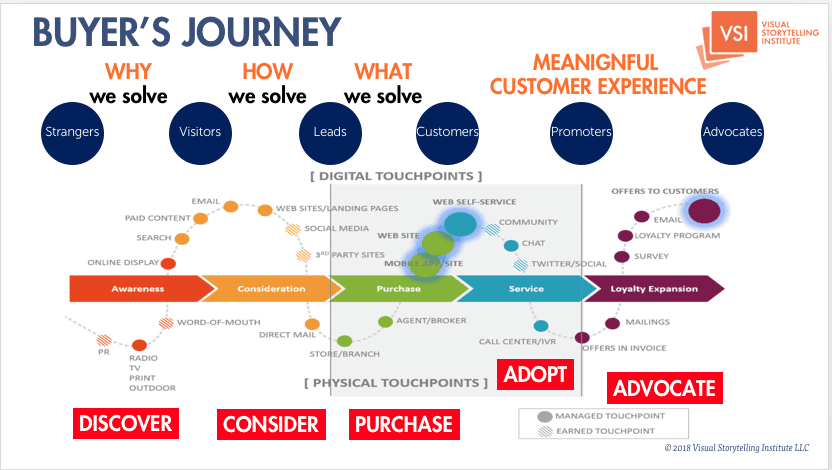
How to find customers? What steps to follow to find customers? What is the method to find customers? We will see together the 6 steps to find customers for your business.
The method to find customers
Prospecting clients without strategy is like trying to hit a blindfolded target. Some succeed with their flair or network to attract customers but relying on the only chance is obviously not the best approach to methodically generate a steady, predictable, and exponential flow of customers for your business.

1. We will see first the method to find customers
2. Then in a second time, the different ways to find customers who are available to you
Step 1: Learn how to select your customers
How to choose your customers? How best to target them? Identifying a specific target is the most potent lever not to disperse your prospecting efforts.
It is indeed always more effective (and cheaper) to touch precisely 5% of a market than to fire mortar on a poorly defined target.
By taking too large a target (e.g. “targeting SMEs with more than 20 employees”), you run the risk:
1. Not to cover the 1/4 of this target before having already spent your entire budget
2. To prospect customers who will never be interested in your products and services anyway
3. To consume unnecessarily human resources and time that could have been invested to conquer your target
The majority of companies tend to work with just about any client, as long as the client is interested in their product or service. A strategy that indeed allows reducing turnover in the short term but also prevents you from looking for the best customers.
Yet, every customer is not equal: try to sell a “management training” to a craftsman. Beyond 200 or 300 euros, you will suffer a refusal when the same training sold to a leader of a consulting firm may be charged 4000 euros.
Why? Because you do not bring the same value to the craftsman and the consultant for whom each day of productivity gained represents 1500 or 2000 euros.
By seizing opportunities when they arise and not selecting your customers:
1. You twist your offers to suit the profile of each client
2. You do not develop specific products, solutions or methods
3. Your solutions n ‘ So,
if the customer chooses you, he will balance your rates before making his decision
5. You can not charge premium rates
. your solutions do not appear to be unavoidable
7. You must find more customers to generate sufficient revenue
8. This time lost due to lack of profitability prevents you from conquering your ideal client
So start by defining your ideal client before going hunting for customers.
Step 2: Define your ideal client
To understand who your perfect customer is, you need to be aware of who your “bad customers” are:
Your “bad customers”:
– Do not perceive the value of your services, services, and products
– Request more effort, time and budget to generate a sale
– Do not understand the level of your tariffs and negotiate downwards
– Need more attention to be satisfied
– are less profitable (and therefore bring you more customers to maintain your figure)
– Eat the time left to get your natural customers
Your “ideal customer” on the contrary:
– Understands immediately what your offers can bring
– Decide faster to take action
– Allow high returns
– While quickly extracting much value from your products or expertise
– Give you time to find new customers
Set aside unprofitable, time-consuming, and stressful customers to focus on the best customers.
Defining your client is the key to an effective prospecting strategy.
List your current customers or the customers you would like to reach: – Which are your most profitable customers?
– Which do not take months to make their decision?
– Which customers do not look at your prices but the value you bring them?
– Which customers are most satisfied with your services or products?
– What are the conditions for you to deliver the best results with these customers?
On Web marketing Consulting, my ideal client is the head of a communication agency or a B2B consulting firm of at least 10 employees who already have a website as a working base, eager to learn, aware that marketing has evolved and traditional business practices are running out of steam.
My ideal client must already have clients to make the most of my advice and absorb the cost of coaching. Finally, he must be able to be actively involved in moving his business towards more traffic, more customers, and more turnover.
Clearly identifying your ideal customer only has advantages:
1. You focus your prospecting efforts on the best customers
2. You can offer solutions and/or products cut to seduce these customers
3. You can increase your prices because you are more precise in your response to the needs of the client
4. By charging more, you free valuable time to explore
5. You are better aware of where your customers are (at home, in a company, on the Internet …)
6 You avoid unnecessary tasks: sterile customer appointments, no-show quotes, answers to emails, and the phone …
7. You better control each euro spent
8. You can understand a posteriori what works and does not work to improve your future campaigns
Take 15 minutes to think about the customer profile that best meets these criteria:
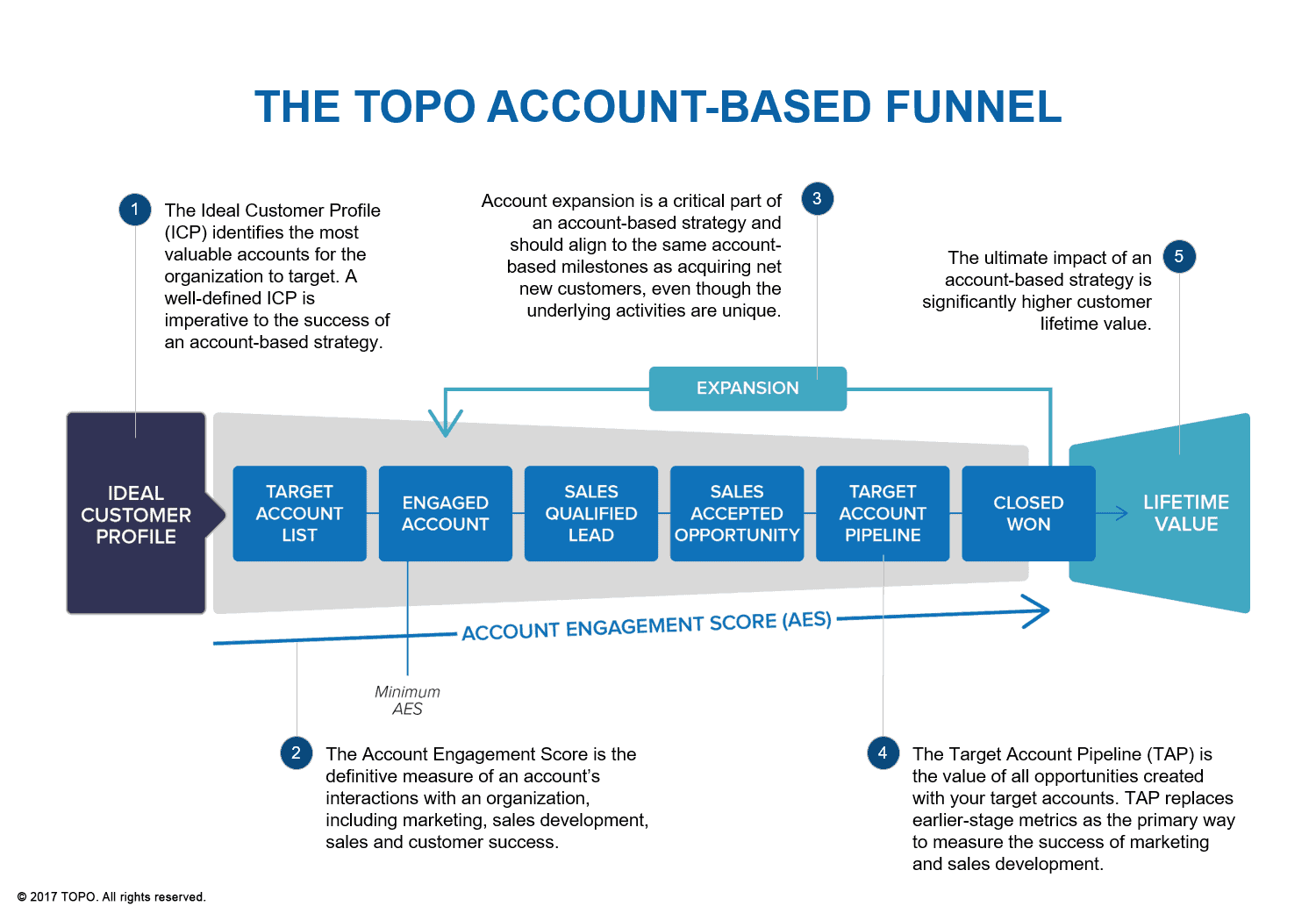
2. In hollow, having defined your ideal client should allow you to:
1. Deny unprofitable, time-consuming and stressful customers
2. To free up time to conquer the best customers
Now that you know your best customers, paint a portrait of your ideal client:
– The average age of your most profitable customers? (the one who makes the decision to buy)
– his profession, his position, his level of study (manager, marketing manager, civil servant …)
– his family status? (father, mother, single, child)
– The city in which he lives?
We call these profiles “personas.” I advise you to limit to 1 to 3 profiles maximum if you start.
Example of a simple persona: Alexis, 35, New York, marketing director of a consulting firm, the problem of traffic and conversions.
Michel, 45, Chicago, director of the consulting firm, customer acquisition problem
Defining “personas” is not a waste of time and allows:
1. To understand the expectations of these clients precisely (simpler than to understand what “women between the ages of 30 and 50” want)
. a much more elegant way with these customers by adapting your messages, your designs, your documents, your visuals.
Example: Hootsuite, a tool to manage social networks, has identified his personas. A priori, it is the community managers, a generally young population. Their communication thus stages these people with, for example here a “pretty girl dressed trendy with a Mac on the knees in a wooden chalet.”
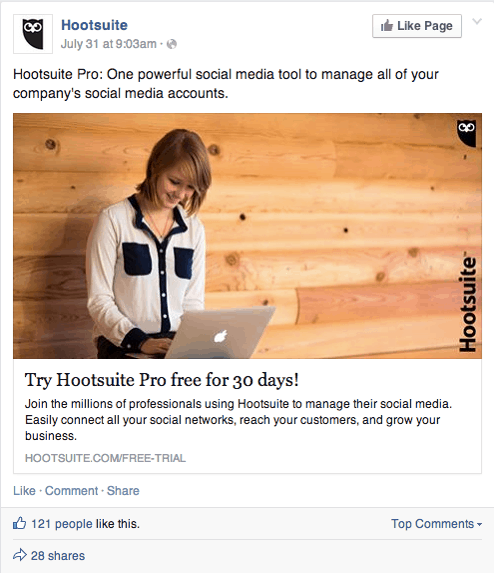
If this company did not have a good knowledge of the profiles of its customers, it would indeed have shown a man in a suit in an open space.
Step 3: Define the main offer
One mistake I often find is the lack of a well-known central offer (“core offer”). They have 5 sometimes 10 types of proposals (services, training, products …) to meet the expectations of each of their customers.
Three main reasons:
– These companies accept all contracts as long as the customer pays.
– They have a varied clientele because they have not defined an “ideal client” and are asked about different topics.
– They have always worked by offering a “catalog of offers” they explain face-to-face.
A prospect rarely looks for a full range of offers. He usually contacts you because he has a “problem” to solve. To sign up with your company, a prospect must have the feeling that you can propose a relevant and tailor-made solution to “his” problem.
Defining a “core offer” (compared to a complete catalog) allows you to be the best on the type of offers that brings the most value to your ideal client.
Example: if you are an IT consulting firm with a recruitment problem, if you use an HR firm, which offer will you choose?
At. The offer of Consultor HR specialist recruitment of high quality IT consultants with 10 years of experience in this field for 10 000 euros
b. The Recruiter Agency offer that recruits in the building, catering and sometimes computer development with its delivery to 8 000 euros
You choose the service that guarantees a high level of quality.
By defining the “core offer” that best meets the expectations of your ideal client:
1. Your prospecting will be simpler
2. You will sell more
3. You will easily dominate your niche
4. You will be identified as a “specialist.”
5. You can increase your methodology over time
6. You will, therefore, be able to increase your prices
7. As you guarantee better results
To define your main offer:
1. Get away from the recurring problems of your “ideal customer.”
2. Take stock of the offers and products you sell easily
3. Analyze which of your suggestions are the most profitable, bring a lot of value to the customer in a minimal amount of time
4. Conquer your ideal client with this main offer
Nothing prevents you from creating additional offers or products to increase the value of each customer. However, as you will attract similar customers, your suggestions will be suitable for your entire portfolio.
Nothing prevents you from finally creating a second “core offer” for a second profile of “ideal client” once you dominate this first market.
Step 4: Build your system to find customers
How will you find and attract new customers? To recruit customers continuously and predictably, you need to set up a prospecting strategy within the framework of a transparent organization.
Prospecting strategy simply means defining:
1. Through which stages, a prospect must go to become a customer
2. Who does what in your business at each step
Your company, of course, has an approach, strategies, and prospecting techniques that are specific to your market and your customers. However, to put on paper, this process is essential.
The definition of your conversion tunnel must allow:
1. Better define by which stages the customer will have to go before buying
2. Optimize your communication campaigns to determine which channel gets the best performance
3. Identify bottlenecks and steps to improve to avoid needlessly lost customers
4. Distribute tasks within your team and empower each step of the conversion funnel
Consult the tools guide to finding customers
To close a sale, customers need to be accompanied during each stage of their purchase, the first time they hear about your business or brand until they take out their credit card.
After the sale, the establishment of a quality customer relationship will allow you to sell again and ensure by specific actions that each conquered customer talks about your offers to their entourage.
Reflection to improve each of these steps can significantly improve the margins of your business.
By focusing on each step of the conversion funnel, you can improve the quality of service, eliminate the brakes that prevent the purchase (waiting time, customer satisfaction …), add value to sell more, better and longer .
Each job has its peculiarities. There are as many transformation tunnels as there are strategies.
Step 5: Optimize your sales system
Each sales tunnel needs to be optimized to produce profitability.
In a highly competitive system, your new sales channels usually do not work right away. Concentrate on 2 or 3 channels then optimize them by learning from your mistakes.
Example: If you are doing exhibitions: your 1st booth will be average, you will not capitalize your contacts correctly, and you will lack documentation. In the 10th, for the same investment, you will return much more turnover.
Example 2: If you have salespeople: a cold calling method works but with meager conversion rates. By optimizing processes, industrializing your way and segmenting your customers more precisely, your salespeople will become more efficient.
Example 3: If you are advertising Facebook or Adwords: your first campaigns will be expensive. Utilizing optimization, you will generate recurring sales.
Step 6: Organize your business to prospect, sell, resign
In the excellent book Predictable Revenue by Aaron Ross, former director of development and acquisition of Salesforce, he develops several exciting ideas.
He distinguishes 3 ways to find customers:
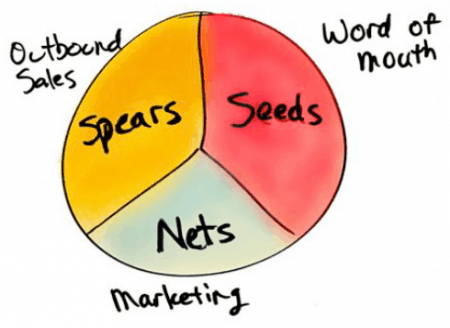
1. Spears: these are outbound marketing techniques that consist of attacking the client (calls, emailing, advertising …)
2. The nets: all inbound marketing techniques consisting of attracting customers to your trays (leads generated through your content, SEO …)
3. Seeds: word-of-mouth, the result of your quality work
Three strategies obviously complementary and reinforcing each other.
Example: A client on appointment will do a parallel search on Google to see if what you return online is the impression left by the face-to-face.
Aaron Ross suggests organizing your sales teams according to their qualities and according to a well-defined process:
1. A group of hunters: specialized to get leads and qualify the right contacts
2. A team of fishermen: who manages to generate and qualify leads inbound
3. A group of closers: who recover qualified leads and are responsible for having the client sign
4. A team of farmers: the objective of which is to identify needs among existing clients and to increase the number
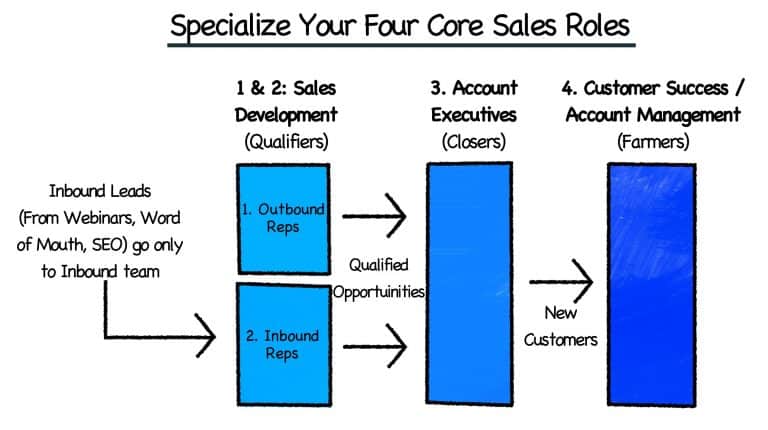
To go further:
Consult the guide to find customers
Consult the tutorial to find customers in B2B
Consult the tutorial to find customers on the Internet
Consult the tutorial to prospect a big account If you want to go faster in setting up your traffic strategy, prospects, and customers, get along.
